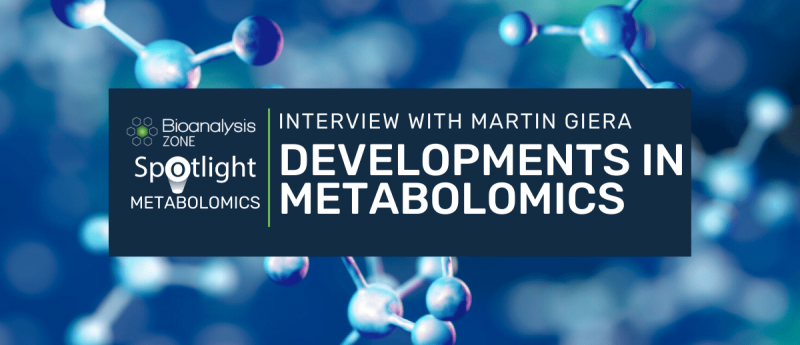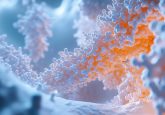The latest metabolomics developments: an interview with Martin Giera

Metabolomics expert Martin Giera, Head of the Metabolomics Group at the Leiden University Medical Center (LUMC; Netherlands), tells us about some of the latest metabolomics developments. Martin discusses his inspirations, the work being carried out at LUMC and what’s happening at the cutting edge of metabolomics research. Is it possible that activity metabolomics could shape our future understanding of biological systems? Read on to find out more.
Martin Giera is Associate Professor and Head of the Metabolomics Group at LUMC in the Netherlands. He obtained his PhD degree from Ludwig-Maximilians Universität München (Munich, Germany) and did international postdoctoral training at the VU University Amsterdam, the Netherlands. He was an Assistant Professor at the VU University Amsterdam, Visiting Scientist at Harvard Medical School (MA, USA), Head of the Lipid Analysis and Biology group at LUMC and Visiting Professor at the Scripps research institute (CA, USA).
Martin is an internationally renowned expert in metabolomics, lipidomics, lipid mediator analysis, medicinal chemistry and bioactivity testing. He is interested in immune cell metabolism, inflammation and the exploitation of metabolomics to define novel drug targets with a special focus on distal cholesterol biosynthesis and its druggability for enhancing inflammation resolution. His research group develops novel applications and approaches in the field of lipidomics and metabolomics with a special focus on translational research enabling the application of ‘omics’ analysis in a clinical setting. His research stretches from fundamental investigations to his involvement in several clinical trials.
Martin has been a DAAD fellow (The German Academic Exchange Service, Bonn, Germany) and is a permanent member and chairman of the interdisciplinary committee of FWO (Flanders Science Foundation, Brussels, Belgium). He was Guest Editor for Frontiers in Immunology, Methods in Molecular Biology (Clinical Metabolomics: Methods and Protocols), Chromatographia (Recent advancements in clinical metabolomics) and Molecules (Metabolomics in Clinical Research) and is on the editorial board of Molecules (MDPI) and Frontiers in Molecular Biosciences. Martin is coordinator of the multi-national H2020 ITN consortium ArthritisHeal and project leader and participant of various Dutch and European grants. He is currently track chair of the ‘Omics’ track at the SLAS2021 conference in San Diego (CA, USA).
QWhat inspired your career in bioanalysis? Is there a particular reason much of your research focuses on metabolomics?
I guess that goes back to high school. I was not a particularly good student, however, my chemistry teacher (Dr Udo Niederreuther) really sparked my interest in the field of chemistry. Later I decided to study pharmacy as I was attracted by the interface of chemistry and biology. Ultimately, during my PhD I developed an assay for the GC-MS based identification of drug targets in distal cholesterol biosynthesis [1]. However, I always wondered about all the possible biochemical changes drug molecules induce which we cannot see because our bioanalytical view is too narrow and this ultimately led me to the field of metabolomics. In other words, I never believed in selective drugs just inhibiting a single enzyme without further reaching biochemical consequences and metabolomics finally helped me dig into this. I guess you could also describe it as a drug induced biochemical butterfly effect.
QWhat is the current focus of the metabolomics research being carried out at LUMC?
Although most of our projects are of translational nature our research stretches from fundamental investigations and the development of novel analytical approaches to our involvement in clinical trials. This involves fundamental investigations such as our recent work on DHCR24 as pro-resolving drug target [2], the development of analytical techniques, for example our quantitative NMR-based metabolomics platform for the analysis of cellular metabolism [3] or the quantitation of drug molecules and metabolites in clinical trials [4].
QMuch research focuses on the use of metabolomics in biomarker discovery. How does this work and what techniques are used to achieve this?
Usually this is carried out in a patient – control setting comparing a control group to a patient group. Very frequently such studies are executed employing LC–MS but also GC-MS and NMR analyses are being applied. However, such studies, particularly when aimed at blood derived biomarkers are frequently jeopardized by confounding factors, think about age, gender, time of blood collection, fasting versus non-fasting and so on. In turn, study design and execution, closely following established protocols are mandatory and might decide about success or failure.
QIn a 2019 review, you discuss the use of metabolomics to understand how the metabolome influences other ‘omics’. Can you summarize the concept of ‘activity metabolomics’ and what impact it is having?
What ‘activity metabolomics’ ultimately wants to achieve is linking an organisms’ phenotype to its metabolic drivers. In other words, to understand and appreciate metabolites as active drivers of biological phenotypes. This goes far beyond the concept of biomarker discovery and ultimately aims at shaping biology by metabolic interventions. Just to name a couple of examples, the involvement of cholesterol biosynthesis intermediates in oligodendrocyte re-myelination [5], metabolic control of immune cell phenotypes [6], short chain fatty acids as key intermediates in host-microbiome interaction [7] and many more.
You might also like…
- Spotlight content #1
- Spotlight content #2
- Spotlight content #3
Q Are there any particular challenges currently facing scientists like yourself in the field of metabolomics? How are you/the research community hoping to address these?
I think the biggest challenge for the entire field of metabolomics is clinical translation. To my knowledge no widely accepted metabolomics-derived biomarker has yet entered clinical routines. There are some out there, think about TMAO for example, however, TMAO is still controversially discussed. Other biomarkers might be difficult to analyze or interpret or are just being regulated locally. Moreover, I think that the metabolomics community must better integrate with clinical chemistry as well as clinicians to precisely understand unmet clinical needs and frameworks. It is one thing to find a possibly dysregulated molecule in a group of patients but it is an entirely different ball game understanding the underlying biology, establishing the usefulness of a certain biomarker in clinical decision making and ultimately making doctors use it. So, in the end, communication will be key.
Q Metabolomics has grown massively in recent history, what do you think the future might hold for the field? Are there any developments you are excited to see?
Considering the limited success of metabolomics in delivering clinically useful biomarkers I am recently very much excited about a shift away from sole biomarker discovery to helping understand and shape biology. I think this is where metabolomics will become key. Think about bioengineering, the unravelling of novel drug targets or possible off-label use. I really hope that big pharma will ultimately adopt metabolomics and make it an integral part in understanding and shaping novel drug molecules. Ultimately, I hope that we can comprehensively map human metabolism and understand how to modify it in order to restore system homeostasis in case of disease.
Make sure you don’t miss our Spotlight to find out more about the latest metabolomics developments.
[Button]
[1] Müller C, Junker J, Bracher F and Giera M. A gas chromatography-mass spectrometry-based whole-cell screening assay for target identification in distal cholesterol biosynthesis. Nat. Protoc. 14(8), 2546–2570 (2019).
[2] Körner A, Zhou E, Müller C et al. Inhibition of Δ24-dehydrocholesterol reductase activates pro-resolving lipid mediator biosynthesis and inflammation resolution. PNAS. 116(41), 20623–20634 (2019).
[3] Kostidis S, Addie RD, Morreau H, Mayboroda OA and Giera M. Quantitative NMR analysis of intra- and extracellular metabolism of mammalian cells: A tutorial. Anal. Chim Acta. 980, 1–24 (2017).
[4] Haeberle H, Prohaska S, Martus P et al. Therapeutic iloprost for the treatment of acute respiratory distress syndrome (ARDS) (the ThIlo trial): a prospective, randomized, multicenter phase II study. Trials. 21(1), 242 (2020).
[5] Hubler Z, Allimuthu D, Bederman I et al. Accumulation of 8,9-unsaturated sterols drives oligodendrocyte formation and remyelination. Nature. 560(7718), 372–376 (2018).
[6] Jha AK, Huang SCC, Sergushichev A et al. Network integration of parallel metabolic and transcriptional data reveals metabolic modules that regulate macrophage polarization. Immunity. 42 419–430 (2015).
[7] Li Z, Yi CX, Katiraei S et al. Butyrate reduces appetite and activates brown adipose tissue via the gut-brain neural circuit. Gut. 67(7), 1269–1279 (2017).
The opinions expressed in this feature are those of the author and do not necessarily reflect the views of Bioanalysis Zone or Future Science Group.





